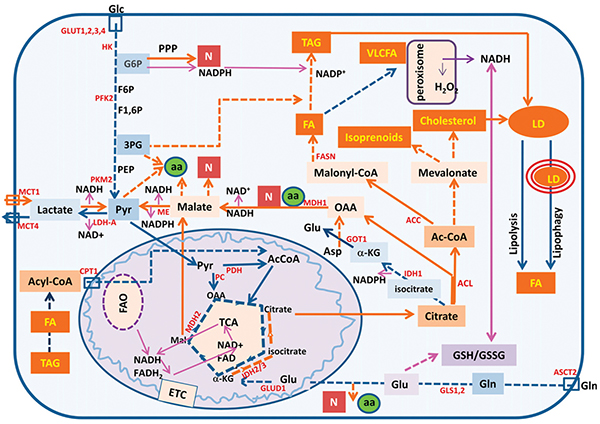JLR: Using microRNAs to target cancer cells
Lipids form the membranes of our cells and serve as rainy day fuel. However, cancer cells have a habit of dysregulating every possible pathway they can, including lipid metabolism, generating an overabundance of lipids. Fortunately, the body already produces molecules that have the potential to stop this dysregulation in its tracks: microRNAs.
 Summary of the metabolic pathways altered in cancer that are described in this review
Summary of the metabolic pathways altered in cancer that are described in this review
In in the , and of the Madrid Institute of Advanced Studies delve into exactly which microRNAs can be used to target cancer cells.
Lipids, molecules known for their insolubility in water, are synthesized to provide membrane integrity and are signaling molecules used by downstream effectors in the cell. As an energy source, lipids are broken down via beta-oxidation, and the intermediates can be used in other metabolic pathways.
MicroRNAs, meanwhile, are small single-stranded RNA molecules that can stop the synthesis of proteins. They bind to mRNA transcripts in the cell and cause their degradation, preventing production of proteins that cancer cells so desperately need.
The authors of the JLR review discuss several lipid-metabolism enzymes that cancer cells rely on whose targeting could prevent the synthesis and dissemination of lipids altogether. For example, an enzyme called fatty acid synthase, which is involved in the making of lipids, is upregulated and overused in cancer cells. Activation of a microRNA targeting this gene may shut down production of this enzyme and turn off this essential pathway. Mono-acyl glycerol lipase, which is involved in storing these lipids, may also be targeted.
Why is all of this important? If researchers can use normal cells’ machinery to target cancer cells specifically, the cancer may be slowed or completely halted. In fact, scientists have used antisense oligonucleotides that bind to microRNAs and repress their action as well as primary microRNAs, which mimic RNA of choice and activate their function. These methods have been used as cancer therapy in clinical trials.
MicroRNAs stand out from conventional gene-therapy-based approaches and have a niche in lipid metabolism. They can be designed specifically to target a gene and serve as modulators rather than on/off switches. Increased lipid formation and breakdown in cancer cells creates vulnerability that might be taken advantage of by microRNAs. In addition, cancer as a whole involves a combination of many factors, and microRNAs could lead the attack as professional pathway regulators to reset the normal metabolic landscape.
Enjoy reading ASBMB Today?
Become a member to receive the print edition four times a year and the digital edition monthly.
Learn moreGet the latest from ASBMB Today
Enter your email address, and we鈥檒l send you a weekly email with recent articles, interviews and more.
Latest in Science
Science highlights or most popular articles

Neurobiology of stress and substance use
MOSAIC scholar and proud Latino, Bryan Cruz of Scripps Research Institute studies the neurochemical origins of PTSD-related alcohol use using a multidisciplinary approach.

Pesticide disrupts neuronal potentiation
New research reveals how deltamethrin may disrupt brain development by altering the protein cargo of brain-derived extracellular vesicles. Read more about this recent 偷拍偷窥 & Cellular Proteomics article.

A look into the rice glycoproteome
Researchers mapped posttranslational modifications in Oryza sativa, revealing hundreds of alterations tied to key plant processes. Read more about this recent 偷拍偷窥 & Cellular Proteomics paper.

Proteomic variation in heart tissues
By tracking protein changes in stem cell鈥揹erived heart cells, researchers from Cedars-Sinai uncovered surprising diversity 鈥� including a potential new cell type 鈥� that could reshape how we study and treat heart disease.

Parsing plant pigment pathways
Erich Grotewold of Michigan State University, an ASBMB Breakthroughs speaker, discusses his work on the genetic regulation of flavonoid biosynthesis.

Calcium channel linked to cancer drug resistance
Researchers discover a protein associated with carboplatin-resistant retinoblastoma, suggesting this protein could be a promising therapeutic target. Read more about this recent Journal of Biological Chemistry paper.

